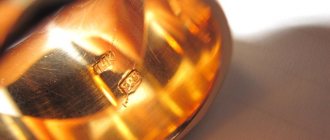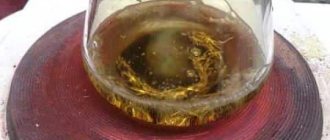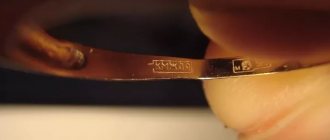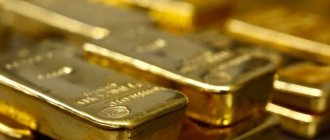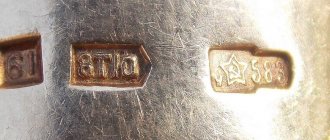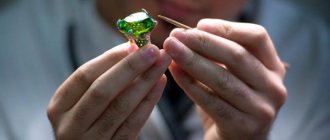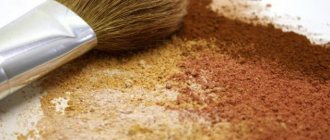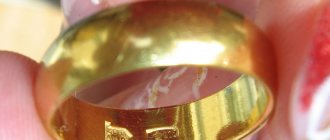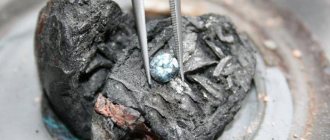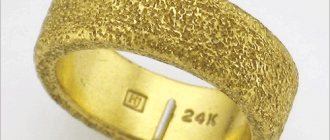Gold solvents are substances that can act on the precious metal and transform the element for some time. Many may ask, why dissolve gold? This process is intended primarily to purify precious metals from impurities and effectively recycle waste.
Dissolving gold in aqua regia
Precipitation and its essence
Precipitation of gold with iron sulfate is carried out when the precious metal is a mixture of aqua regia and a noble element. The color of the liquid may vary; chemists note that the metal dissolved in aqua regia may become cloudy. But there is no need to worry about this.
Iron sulfate is just one of the elements that can be used in precipitation. But in most cases it is used due to its availability. At its core, ferrous sulfate is a powder that has a yellow or greenish tint and is used by chemists and doctors because it is also a medicine.
Precipitation is the separation of Au from solution; If the procedure is carried out using ferrous sulfate, then a certain sequence should be followed:
- It is recommended to dissolve iron sulfate in water, keeping the proportions one to two: one part vitriol and two parts water. If the liquid has changed color, darkened or become cloudy, then nails must be added to it. Clean iron nails will help restore transparency to the solution; usually add five grams of nails per 100 grams of already prepared solution.
- Since aqua regia is a mixture of hydrochloric and nitric acids, refining begins by evaporating the excess nitric acid under a hood. It is recommended to use a hood during the process. To evaporate excess nitric acid from the solution, you need to heat the aqua regia. It should be poured into a porcelain bowl and put on fire; during the refining process, use not only iron sulfate, but also sodium chloride. This element will help prevent the breakdown of nitrogen chloride.
- As the solution heats up, it is advisable to stir it with a special glass stick. You also need to stock up on hydrochloric acid: as it evaporates, it is gradually added to the solution.
- When the consistency of the solution begins to resemble thick jelly or suspension, it must be removed from the heat and cooled. After the solution has cooled, hydrochloric acid is added to it again.
- The next stage is filtering. It is worth adding iron sulfide from which the solution was previously prepared to the filter.
- If everything is done correctly, the gold contained in the mixture of reagents will turn into a red or orange precipitate. It will be a powder, which is called "heavy" because the sediment remains at the bottom of the vessel. It is clearly visible.
But the deposition of gold does not end there. It is necessary to collect the sediment, rinse it under a stream of water and dry it using a paper filter. When the particles are dry, the filter is burned or thrown away, and the powder that was obtained during the refining process is the gold that was previously dissolved in aqua regia. The amount of impurities in the precious metal is not too large; it is often possible to obtain gold of a high standard.
The deposition can be considered complete at this point. But the resulting Au particles must be melted into an ingot or small piece.
What should not be used in the process?
There are also substances with which there is no point in conducting experiments, because they will either give absolutely no reaction or will aggravate the recovery process. This list includes:
- Potassium cyanide. The method is only suitable for the recovery of gold chloride from a neutral solution. In other cases, no reaction will occur.
- Ammonia hydrate and ammonium carbonate. Substances should not be used in the process. If precipitation does occur, drying the resulting gold is hazardous to health. The result of the process is explosive gold, which tends to explode unexpectedly.
- Mercury nitrate. Precipitation produces a fine sediment, and the vapors produced during the process are deadly.
- Citrates, tartrates and potassium acetates will not help restore gold from aqua regia.
And although as a result of all actions you can get 999 gold. Restoring metal is a labor-intensive process that may not be easy for beginners the first time. It is important to comply with all deadlines and proportions. Therefore, when performing it, you should definitely take care of your own safety, since the cost of the experiment can be really high.
Step-by-step instructions for refining gold at home and in the laboratory
Gold refining is the process of purifying yellow precious metal from various impurities, as a result of which it is assumed that it is possible to obtain pure precious metal. Gold refining can be carried out at home and in the laboratory. The specifics and features of this process depend on the methods and location of its implementation. We invite you to familiarize yourself with alternative methods of refining gold at home and in the laboratory.
Methods
Refined (pure) gold can be obtained by electrolytic or chemical methods. In jewelry production, as a rule, a chemical refining method is used due to the fact that the feasibility of using the electrolytic method manifests itself only with large volumes of precious metal and regular use, that is, in large production.
In general, experts usually name three alternative methods for purifying gold from impurities:
- wet (chemical);
- dry (chlorine treatment);
- electrolytic.
The chemical method is designed exclusively for processing those precious metals (including gold), the impurities of which may contain not only other metals, but also their compounds or natural alloys.
The choice of method and method for refining gold mainly depends on the composition of the alloy or compound.
If the alloy contains a large amount of silver, which, as is known, prevents its dissolution in aqua regia, forming an insoluble layer in acid, copper is usually added to such an alloy as a “baking powder”.
It is important that the percentage of silver in such an alloy is at least five percent of its total mass.
The components are then dissolved in nitric acid, which helps remove unwanted silver particles, and the precipitated metals are oxidized using aqua regia and then reduced. In the case of gold, this reducing agent is tin chloride.
Refining gold through the use of chlorine involves grinding an alloy of metal into a powder and passing chlorine gas through the heated powder. The result of this reaction is the following: a metal salt is formed (in the case of gold, gold chloride).
If the impurity contains other metals, then it is important for you to know the following: with high heating, silver chloride is concentrated in the upper part, and salts of other metals are located below.
The electrolytic method involves the deposition of precious metals on an electrode. It includes two stages:
- Dissolution of one of the electrodes in aqua regia or hydrochloric acid, which occurs under the influence of current.
- Deposition of precious metals on the second electrode, which occurs in the form of layers, the first of which will represent the most noble metal.
To obtain gold by electrolytic refining, it is necessary to use gold of at least 950 purity. Only from such material can you obtain Fine Gold of 999.9 purity.
We will discuss other methods of refining gold at home and in the laboratory in detail below.
Where is this precious metal found?
Hundreds of tons of gold are used annually in the production of radio components and computer chips. Contacts made of this metal are characterized by high electrical conductivity, they are not subject to oxidation, and therefore are widely used.
Gold
is contained in the following components :
- diodes;
- transistors;
- glass electrodes;
- relay;
- ports;
- jumpers;
- motherboard memory modules.
Note that in practice there may be much less gold in radio components than there should be according to documents (especially in technical products made after 1989).
Where to deliver the received material and at what price?
The gold ingot (barrel) obtained as a result of purification most often has insignificant weight. However, even in such quantities it is of interest to buyers.
Advertisements for buying gold can be easily found on the Internet or in local newspapers.
Often, solid metal is purchased by the same companies that buy radio components.
(for example, aluminum or brass) may also be interested in gold
If the buyer is in the same city as the seller, the transaction is completed upon visiting the specified address.
The buyer himself weighs the metal and checks its quality, after which he sets a price. Of course, if possible, it is advisable to check all offers on the market in order to choose the most profitable one. The bullion can be sent to another city by mail, cash on delivery.
Some pawnshops are also ready to accept goods of this kind. To find out at what price the establishment will be willing to purchase gold, contact a pawnshop employee. Another option is to submit an ad yourself . In this case, you just have to wait for a call from a potential buyer.
If you engage in refining on an industrial scale, you should rely on existing laws.
To legally engage in the circulation of precious metals, you need to register as an individual entrepreneur or create an LLC.
When selling gold, focus on its purity and market value.
The price per gram of 999 fine precious metal is set by the Central Bank of Russia . Since 2004, its prices have been continuously rising. The most significant jump was observed in 2016, when the cost exceeded 3 thousand rubles per gram.
Step-by-step instructions for extracting metal from radio components and microcircuits
To extract gold from microcircuits and radio components, it is advisable to use aqua regia .
To refine gold using this method, you must perform the following steps :
- grind the components mechanically, separating the parts that contain gold;
- get rid of organic matter by burning or calcining;
- open the windows in the room for better ventilation;
- for experiments, prepare a vessel made of borosilicate glass;
- place the workpieces in a concentrated mixture of 36% hydrochloric acid (3 parts) and 95% nitric acid (1 part) in small portions - up to 3 grams at a time, 500 ml of aqua regia will be required per 100 g of raw materials;
- Heat the solution while gradually adding nitric acid;
- check the presence of gold with tin chloride;
- filter the solution, then remove nitric acid from it.
Gold can subsequently be reduced using ferrous sulfate, perhydrol, oxalic acid or hydrazine sulfate. The resulting gold is smelted into an ingot using a crucible .
Note that it is unsafe to purify gold at home due to the significant causticity and toxicity of the substances used and the volatile compounds released.
In addition, advanced knowledge of chemistry will be required.

